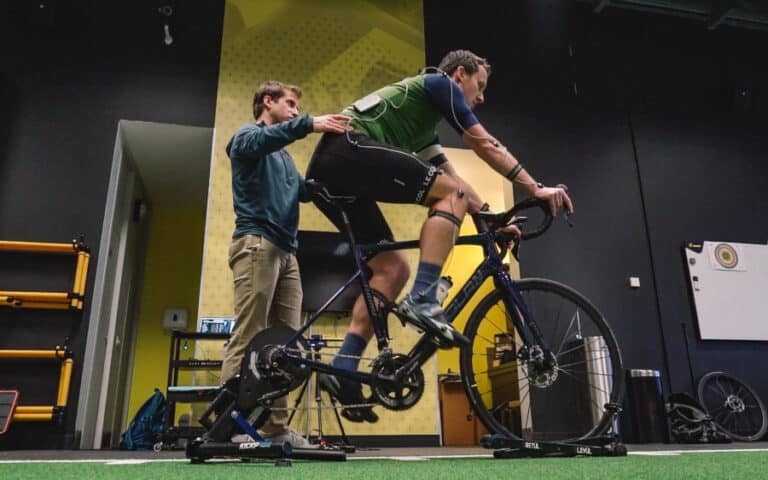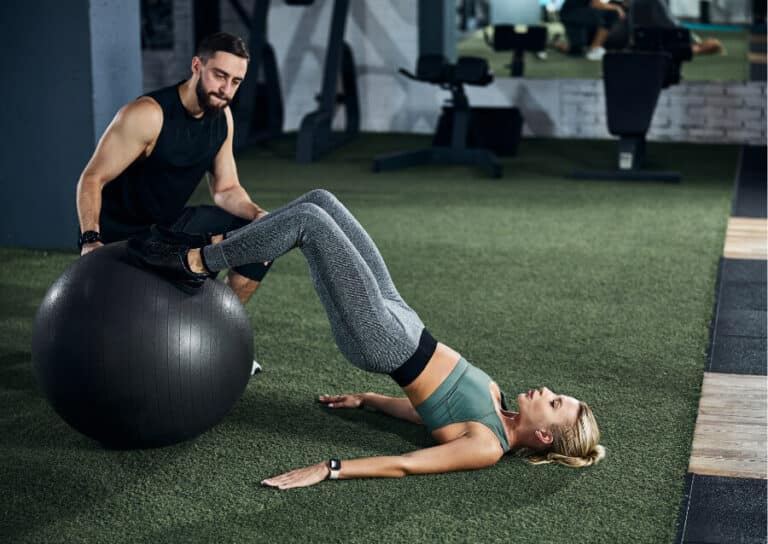ACCURATE DIAGNOSIS AND PROGNOSIS ARE THE CORNERSTONES OF ANY SUCCESSFUL REHABILITATION. THIS IS PARTICULARLY RELEVANT WHEN DEALING WITH THE MOST COMMON MUSCLE INJURIES, AND SEVERAL FACTORS WILL BE TAKEN INTO CONSIDERATION WHEN DETERMINING THE MOST APPROPRIATE MANAGEMENT PLAN.
Underpinning our approach to muscle injury is the fact that no clinical test or image finding is more important than the collective information gained. We recognise that appropriate imaging provides important information when building a clinical picture, but we strongly believe in an approach where we “treat the athlete, not the scan”.
As such, the most important clinical information is “the individual”, and an acceptance that individual characteristics, response to pain and previous history will impact on our decision-making, both in the early phases of management and later in the process when the clients personal demands will be factored into appropriate outdoor loading.
Imaging of muscle injuries is important for sports medicine practitioners and is regularly used in elite sports medicine. To date, several muscle injury grading systems have been proposed, but they remain inconsistently used and understood across elite sport and between practitioners. It is therefore important to have a sound understanding of each grading criteria, and how the information gained can assist the process of accurate diagnosis and optimal rehabilitation of muscle injuries.
This is an excellent explanation on muscle injuries by former Arsenal and England mens team Doctor, Dr. Ian Beasley.
When to image
Imaging for muscle injuries is used when it is deemed appropriate to inform the clinical diagnosis or likely to provide information which will inform the Return to Play (RTP) plan. Although it is accepted that image findings often lag behind clinical findings it can be useful to do follow up imaging in specific cases, such as those with tendon injury involvement when a slower healing response results in a potentially poorer scar and the clinician is looking for more certainty before exposing the healing tissue to higher loads.
Back to acute injury management…
The medical staff (sports medicine doctor or Sports Physiotherapist) complete a clinical examination and, once it has been decided that a muscle injury has occurred, makes a decision in conjunction with the client regarding imaging. The key information expected from an MRI report for a muscle injury is detailed below.
With skilled clinicians the imaging should be seen as a confirmatory process whereby clinical findings are subsequently supported by image findings however on occasion the image findings can come as a surprise and therefore imaging is valuable to protect the team against an unexpected tendon involvement or more significant muscle fibre disruption.
Essentially if it presents as a significant muscle injury (with potential tendon involvement) then the client will present with both pain and loss of power and this will be supported by image findings; on rare occasions however they can present well clinically and then a more significant injury will be reported from the scan.
In these cases it’s important that we continue to treat the client clinically whilst RESPECTING the image report and not being absolutely dictated to by it.
Typically (assuming an acute injury), we will wait between 36 and 48 hours before carrying out imaging to avoid false positives (typically with lower-grade muscle injuries when an oedema pattern may take a number of hours to develop) and false positives (typically in higher-grade injuries when the degree or swelling and bleeding can cloud the ability to accurately identify structural damage).
Information to ensure accurate diagnosis
Involved muscle
Which muscles are involved is clearly important, and at times this can be difficult to ascertain solely from a clinical examination. Large biarticular muscles that contribute significant force to the actions of a person (for example, biceps femoris, rectus femoris) are likely to be treated more cautiously than isolated low-grade injuries to smaller secondary contributors (for example, adductor brevis, obturators).
Determining the injured muscle will impact upon the first and most important decision faced by the medical staff: whether to rehabilitate or manage while keeping the client available for training.
Grade of muscle injury
Several criteria for evaluating and grading muscle injury have been presented in the literature, with significant variation in implementation across sports and among practitioners. However, the key information that informs diagnosis and possibly prognosis is recognised as the presence and extent of muscle fibre disruption, as well as the associated oedema pattern. Therefore, in an MRI report, the extent of muscle fibre disruption (sometimes referred to as macroscopic damage, tearing, architectural disruption or fibre damage), including cranio-caudal and cross-sectional area (CSA) of disruption, is noted. The percentage in relation to total muscle size should also be provided.
UEFA grading system
Measurements of fibre damage form the basis of the grading system proposed by UEFA in 2012. This classifies injury (graded 0-3) based on the CSA of muscle fibre disruption, regardless of oedema. Ekstrand and colleagues found this system was associated with RTP times of hamstring injuries, indicating fibre disruption was predictive of RTP time. However, considering 70% of the included hamstring injuries were found to have no muscle fibre disruption, this seems to be an over-simplified grading system and will not provide differentiation between the large majority of muscle injuries.
BAMIC – British Athletics Muscle Injury Classification
Muscle oedema length has been identified as an important finding on MRI, and furthermore has been shown to be associated with RTP times. The British Athletics Muscle Injury Classification proposed by Pollock and colleagues use oedema length (cm) and CSA (cm and % of total) to grade muscle injuries 0-4. Oedema should be measured and recorded as cranio-caudal dimension and also the CSA, both as absolute dimensions and also as a percentage of total muscle size.
Information to inform prognosis and rehabilitation planning
1. Location
Radiological research suggests that certain anatomical locations may be associated with longer recovery times, for example proximal hamstring injuries. Longer RTP times should also be expected for central distal soleus injuries compared to those situated on the lateral side of the muscle. However, it may be that the type of tissue, more so than the location, is of key importance.
2. Tissue type involved
The BAMIC grading system indicates the tissue structure and the specific location injured. Myofascial, musculotendinous and intra-tendinous are denoted as a, b and c respectively.
a. A myofascial injury is situated at the periphery of the muscle, involving the surrounding connective tissue layers (epimysium, perimysium, aponeurosis). A disruption of these structures may result in intermuscular fluid or haematoma, which should be noted. Myofascial injuries have typically been viewed as less severe than a musculotendinous injury. However, recent radiological research suggests that connective tissue structures play an important role in force transmission, as well as providing essential structural integrity to a muscle-tendon unit. The surrounding connective tissue has deep inlays within the muscle belly, rather than the “sausage skin” structure traditionally described. This connective tissue is thought to provide an anatomical link between the proximal and distal tendons, allowing force transmission and absorption through the muscle-tendon unit. Furthermore, it may be that some injuries to these very small connective tissue structures are below the sensitivity for MRI detection. Therefore, injuries that are clinically positive but lack a positive radiological finding (MRI grade 0) should still be treated with caution.
b. The musculotendinous junction is thought of as the location of greatest force production within the muscle tendon unit, and therefore has a higher incidence of injury than other sites. This may be at the proximal or distal ends of the muscle belly, or indeed within the central part of muscles, which have a large intramuscular tendon component (for example, rectus femoris, biceps femoris, soleus). Here, a ‘b’ injury could extend from the tendon at any level of the muscle.
c. A tendon injury is noted if there is oedema within the tendon, or evidence of tendon fibre damage. This may be a cross-section tear, or a longitudinal split tear. Tendons have comparatively less vascularity than muscle tissue, likely resulting in a slower healing response. Intra-muscular tendon parts have relatively less sensory neural innervation when compared with muscle tissue or the free tendon. This should be considered in the clinical examination and when progressing rehabilitation. Tendons are required to withstand high forces, whilst providing efficient energy storage and release in the stretch shortening cycle during plyometric movements. Considering this, a tendon injury may present initially as having a relatively good level of function, due to an intact muscle unit. However, the clinician should be aware of the increasing contribution of the tendon structure when higher forces and velocities are incorporated into the rehabilitation process.
Anecdotally, involvement of tendon will add from seven to ten days on to the typical length of recovery following a grade 2 injury due to the athlete feeling they can’t quite go to top end speed or kick action.
3. Tendon involvement
Note should be made of involvement of the free tendon (above the level of the muscle tissue) or intramuscular tendon component, as well as any retraction or loss of tension. Care should be taken to correctly identify injuries involving the intramuscular and free tendon, and careful consideration of how this will influence Return to Performance (RTPerf) times and the rehabilitation process.
4. Importance of connective tissue
Epimysium, aponeurosis and central tendon injury are key structures involved in force transmission, and therefore should be considered in any future muscle injury grading systems. Muscle feathering on MRI, which is indicative of myofibril damage, with detachment from the key connective tissue structure, is seen in more severe injuries. The connective tissue component of an injury when situated close to an aponeurosis or an intramuscular tendon is important to note, and may influence time to recovery.
Summary
Although there is some evidence showing correlation of prognosis with grading in the UEFA and BAMIC systems, this only differentiates between large variations in radiological presentations and may not be useful for determining accurate RTP times in many of the mild or moderate muscle injuries.
While MRI grading of injury continues to be an important part of our diagnosis and prognosis process, it should only be confirmatory of an accurate clinical examination. An MRI report is useful when determining involvement of tendon tissue, because the healing properties of tendon tissue (which doesn’t result in early scar tissue formation) will impact on our decision to load early and slightly lengthen the initial prognosis.
BAMIC gradings
Grade 0 – Normal MRI study (0a)
Muscle soreness/DOMS (0b)
Grade 1 – Oedema length <5cm
Oedema CSA <10%
Muscle fibre disruption <1cm
Grade 2 – Oedema length 5-15cm
Oedema CSA 10-50%
Fibre disruption <5cm
Measurements include tendon diameter (for ‘c’ injuries)
Grade 3 – Oedema >15cm
Oedema CSA >50%
Fibre disruption >5cm
No evidence of complete tendon defect. May be some loss of tension
Grade 4 – Complete tear of muscle/tendon
- a) Myofascial
- b) Musculo-tendinous
- c) Intra-tendinous
UEFA grades
Grade 1 – Oedema but no fibre disruption
Grade 2 – Partial fibre disruption
Grade 3 – Complete fibre disruption, total rupture
Muscle injury: proposed MRI report checklist
The following checklist is suggested as being the key information to extract from image reporting and can be shared with the radiologist – this can then be used for auditing purposes as it makes case comparison easier.
**Look out for a follow up blog by Scott McAuley on how this process underpinned his paper on “Predictors of time to play and re-injury with and without intramuscular tendon involvement in adult professional footballers; a retrospective cohort study”
- Site of injury
- Length of oedema CC
- Dimensions of oedema (ML / AP)
- Dimension of oedema (CSA, %)
- Pattern of oedema (i.e. feathering)
- Myofibrilar detachment?
- Intermuscular fluid / haematoma? Size?
- Fibre disruption (yes / no)
- Dimensions of fibre disruption (CC)
- Dimensions of fibre disruption (AP / ML)
- CSA of fibre disruption (CSA, %)
- Central IM tendon involvement
- Tendon fibre disruption / chronic changes
- Tendon or muscle loss of tension / retraction?
Hamstring Checklist
Muscle involved | Bicep Femoris Long Head | Bicep Femoris Short Head | Semi Tendinosus | Semi Membranosus | ||||
|---|---|---|---|---|---|---|---|---|
BA Radiological Diagnosis | 1a | 1b | 2a | 2b | 3b | 3c | 4b | 4c |
UEFA Radiological Diagnosis | 1 | 2 | 3 | |||||
Craniocaudal Oedema Length (cm) | ||||||||
Transaxial Oedema Dimensions (cm) (inc. %) | ||||||||
Macroscopic Fibre Disruption | Yes | No | ||||||
If Yes: | Dimensions (cm) | |||||||
Tendon involvement? | Yes | No | ||||||
If Yes: Tear type? | Longitudinal | Transverse | Other | Dimensions (cm) | ||||
If Yes: Retraction? | Yes | No | If yes: Dimensions (cm) | |||||
If Yes: Loss of tension? | Yes | No | ||||||
Notes: | ||||||||
Anterior Thigh Checklist
Muscle involved | Rectus Femoris | Vastus Lateralis | Vastus Medialis | Vastus Intermedius | Sartorius | ||||
|---|---|---|---|---|---|---|---|---|---|
Notes: | |||||||||
BA Radiological Diagnosis | 1a | 1b | 2a | 2b | 2c | 3b | 3c | 4b | 4c |
UEFA Radiological Diagnosis | 1 | 2 | 3 | ||||||
Craniocaudal Oedema Length (cm) | |||||||||
Transaxial Oedema Dimensions (cm) (inc. %) | |||||||||
Macroscopic Fibre Disruption | Yes | No | |||||||
If Yes: | Dimensions (cm) | ||||||||
Tendon involvement? | Yes | No | |||||||
If Yes: Tear type? | Longitudinal | Transverse | Other | Dimensions (cm) | |||||
If Yes: Retraction? | Yes | No | If yes: Dimensions (cm) | ||||||
If Yes: Loss of tension? | Yes | No | |||||||
Adductor Checklist
Muscle involved | Adductor Longus | Adductor Magnus | Adductor Brevis | Pectineus | |||||
|---|---|---|---|---|---|---|---|---|---|
Notes: | |||||||||
BA Radiological Diagnosis | 1a | 1b | 2a | 2b | 2c | 3b | 3c | 4b | 4c |
UEFA Radiological Diagnosis | 1 | 2 | 3 | ||||||
Craniocaudal Oedema Length (cm) | |||||||||
Transaxial Oedema Dimensions (cm) (inc. %) | |||||||||
Macroscopic Fibre Disruption | Yes | No | |||||||
If Yes: | Dimensions (cm) | ||||||||
Tendon involvement? | Yes | No | |||||||
If Yes: Tear type? | Longitudinal | Transverse | Other | Dimensions (cm) | |||||
If Yes: Retraction? | Yes | No | If yes: Dimensions (cm) | ||||||
If Yes: Loss of tension? | Yes | No | |||||||
Calf Checklist
Muscle involved | Soleus | Gastrocnemius | Plantaris | FHL | |||||
|---|---|---|---|---|---|---|---|---|---|
Notes: | |||||||||
BA Radiological Diagnosis | 1a | 1b | 2a | 2b | 2c | 3b | 3c | 4b | 4c |
UEFA Radiological Diagnosis | 1 | 2 | 3 | ||||||
Craniocaudal Oedema Length (cm) | |||||||||
Transaxial Oedema Dimensions (cm) (inc. %) | |||||||||
Macroscopic Fibre Disruption | Yes | No | |||||||
If Yes: | Dimensions (cm) | ||||||||
Tendon involvement? | Yes | No | |||||||
If Yes: Tear type? | Longitudinal | Transverse | Other | Dimensions (cm) | |||||
If Yes: Retraction? | Yes | No | If yes: Dimensions (cm) | ||||||
If Yes: Loss of tension? | Yes | No | |||||||












